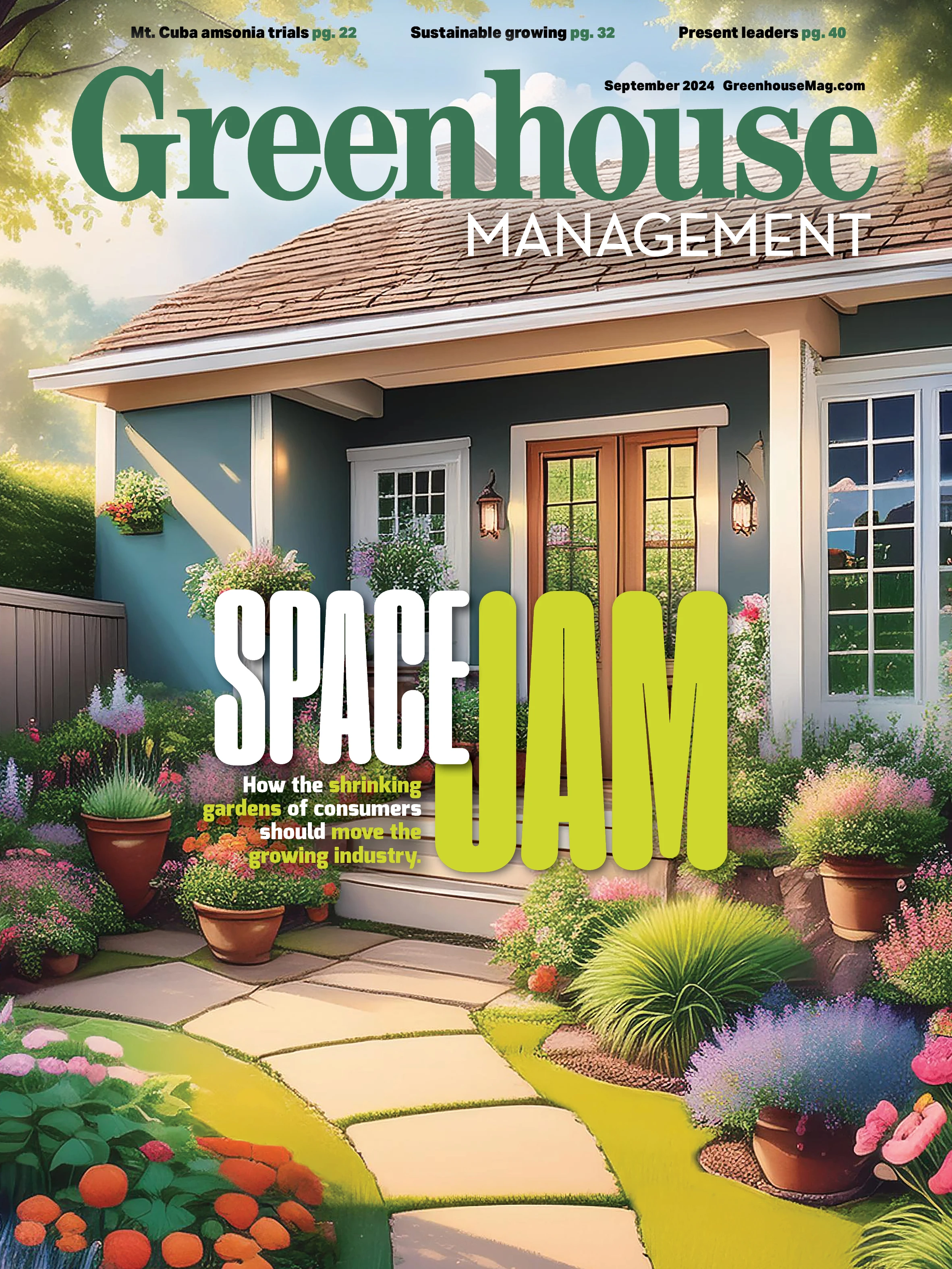
Amsonia, named for 18th-century Virginia physician and botanist John Amson, is a genus of beautiful, adaptable and long-lived perennials commonly known as bluestars. Most Amsonia are native to the United States and Mexico, with two additional species found in Greece and Turkey (Amsonia orientalis) and Asia (Amsonia elliptica). In our trial, we included representatives of three native species — Amsonia ciliata, Amsonia hubrichtii and Amsonia tabernaemontana — as well as numerous varieties, cultivars and hybrids. The non-native A. orientalis was also included to allow for direct comparison to the native species.
Amsonia species and cultivars vary in their overall size and ornamental qualities, such as foliage texture and bloom time, but all provide multiple seasons of ornamental interest. Spring brings sprays of blue flowers, followed by appealing summer foliage. Many bluestars wrap up the year with outstanding gold or orange fall color, particularly when grown in full sun. Bluestars support early-season pollinators, including native bees and hummingbirds, and are the host plant for several species of butterflies and moths. As with many members of the Apocynaceae family, including milkweed (Asclepias), Amsonia produce a milky sap that discourages browsing by deer and other mammals.
Amsonia grow well in a broad spectrum of soil types and sun exposure ranging from full sun to part shade. Bluestars are also exceptionally easy to care for in the landscape. The key to growing Amsonia is patience. As with other long-lived perennials, bluestars take a few years to get established before they show their full potential for flowers, foliage and fall color.
This trial evaluated 20 different Amsonia over a 10-year period and focused on their garden performance and ornamental qualities. Diseases were infrequently observed in this trial, and aside from minor chlorosis and rust, the plants were virtually pest- and disease-free. The Amsonia trial was grown in part-to-full sun in “average” soil, best described as clay-loam with a pH near 6.5. Throughout the trial, plants were given minimal care. Supplemental water was provided only during the first year after planting to encourage establishment. Mt. Cuba Center is located near Wilmington, Delaware, and is within USDA Hardiness Zone 7a.
As the common name bluestar suggests, the flowers of Amsonia are star-shaped and usually light blue. The blue color is often darkest in the buds and lightens as the flowers open and age. White-flowered forms of some species exist but are uncommon. Amsonia bloom for four to six weeks between April and June and display masses of branched inflorescences.
Amsonia leaf forms vary between species. Some bluestars, such as A. hubrichtii and Amsonia ciliata var. tenuifolia, produce fine-textured, thread-like leaves. Others, including Amsonia tabernaemontana var. tabernaemontana, produce broader leaves that result in a coarser texture in the landscape. Additional foliar details that can aid in identification include the presence or absence of hairs, leaf margin undulation and surface sheen.
The Amsonia in the trial garden were planted in a location that receives morning and early afternoon sun and is then partially shaded for the rest of the day. Fall color was generally good; however, plants sited in sunnier locations in Mt. Cuba’s naturalistic gardens produced an exceptional autumn display each year.
Most Amsonia in the trial can be categorized as clump-forming plants that develop a semi-woody crown known as a caudex. Due to the dense nature of this crown and the deep root system, they can be challenging to divide or move once established. Three bluestars in the trial — A. orientalis, Amsonia ‘Blue Ice’ and Amsonia ciliata var. tenuifolia ‘Georgia Pancake’ — have a different habit. These plants spread slowly via underground rhizomes and can be used as a groundcover.
Amsonia produce an initial flush of growth in early spring, and inflorescences are located at the apices of the stems. After flowering, vegetative growth continues via secondary stems that emerge from below the flowers.

Mt. Cuba Center Amsonia trial results
Mt. Cuba’s 10-year Amsonia evaluation aimed to determine the horticultural value of 20 bluestars, some readily available in commerce and others less well known. The trial was planted in 2013, systematic ratings were recorded between 2015 and 2018 and follow-up observations continued through 2023. Each week in spring and summer, the plants were rated on a scale of 1 to 5 (1 being very poor and 5 being excellent) for ornamental qualities including habit, vigor and floral display. Ratings from each year were averaged to determine the final score for each bluestar.
After the results were tabulated, almost every plant in this evaluation could be considered a top performer, with only three of the 20 bluestars scoring below a 4.0. The plants with the highest scores were A. ciliata ‘Spring Sky’ (4.9), A. tabernaemontana ‘Short Stack’ (4.8) and A. tabernaemontana var. illustris (accession B) (4.8). For the entire trial report, as well as charts with all ratings, visit mtcubacenter.org/trials/amsonia-for-the-mid-atlantic-region.
Amsonia ciliata, also known as fringed bluestar, is a large, fine-textured species found in dry sandy soils in the southeastern and south-central United States, although it is adaptable to average garden soils. In the wild, these plants reach 2 to 3 feet in height, but in the hospitable conditions of the trial garden, these attained a size of 4 feet high and 7 feet wide and were some of the largest plants in the trial.
Three hybrid cultivars in the trial had very similar features and performance to A. ciliata. The first, Amsonia ‘Seaford Skies’, is a hybrid between A. hubrichtii and A. tabernaemontana that originated in the Virginia garden of plantswoman and author Pamela Harper. Plant Delights Nursery subsequently introduced this superior bluestar into cultivation. The leaves of ‘Seaford Skies’ are intermediate in width between the two parents and are very similar to those of A. ciliata. One of the most notable features of A. ‘Seaford Skies’ is the late May display of cornflower-blue blooms that have a darker color than other large bluestars.
Two other cultivars, Amsonia ‘Halfway to Arkansas’ and Amsonia ‘Midway to Montana’, were introduced by Intrinsic Perennial Gardens in Hebron, Illinois. Although the parentage of these plants is not known, they are very close in appearance and performance to A. ‘Seaford Skies’ and A. ciliata and could be used in a similar fashion in the landscape.

Amsonia ciliata var. tenuifolia is a smaller variety of A. ciliata with narrower foliage. Five accessions were included in the trial: three plants from Mt. Cuba’s collection that originated from the southeastern United States and two cultivars. Each plant has a compact habit, never surpassing 2 feet high, with very fine-textured, thread-like foliage. Amsonia ciliata var. tenuifolia forms neat clumps, although there is a tendency for stems to flop, a trait that could be improved by siting the plants in lean dry soils and full sun.
The cultivar Amsonia ciliata ‘Spring Sky’, introduced by local plantsman Rick Darke, has slightly broader foliage and a showier floral display than the wild-type plants. This cultivar is much smaller than the examples of A. ciliata described in the previous section, so it is discussed here with plants of similar stature. The second cultivar, Amsonia ciliata var. tenuifolia ‘Georgia Pancake’, is noteworthy for its prostrate habit. Discovered by plantsman Bob McCartney in Georgia and later introduced by Plant Delights Nursery, this is often sold as a cultivar of Amsonia ciliata var. filifolia, a synonym of A. ciliata var. tenuifolia. ‘Georgia Pancake’ fringed bluestar has a height of 9 inches and spreads slowly by rhizomes, eventually forming a unique groundcover.
Amsonia hubrichtiiis native to the Ouachita mountains of Arkansas and Oklahoma and was discovered by naturalist Leslie Hubricht in 1942. The habit, large size and fine texture resemble A. ciliata, but A. hubrichtii has much narrower foliage and lacks hairs on the young leaves. Although A. hubrichtii has a small range in the wild, it has become one of the most popular and widely cultivated bluestars and was awarded the Perennial Plant of the Year by the Perennial Plant Association in 2011. Hubricht’s bluestar is lauded for its soft, thread-like foliage that produces a billowing feathery texture and extends the season of ornamental interest well beyond flowering. This species displays exceptional golden fall color, especially when grown in full sun.
Amsonia tabernaemontana var. illustris, formerly known as Amsonia illustris, is a large bluestar variety from the south-central United States, where it is found in sandy or rocky soils along streams. This plant appears very similar to a different variety, A. tabernaemontana var. salicifolia, but details of the flowers, fruit and foliage can be used to differentiate the two. Close examination of the flowers of Ozark bluestar will reveal hairs along the margin of the calyx in contrast to the hairless calyxes of A. tabernaemontana var. salicifolia. Once the flowers have been pollinated, the ripening fruit of Ozark bluestar hangs downward instead of being held upright. Finally, Ozark bluestar has beautiful shiny leaf surfaces and undulating leaf margins, which is a unique and highly ornamental feature among the trialed Amsonia.

Although we did not trial A. tabernaemontana var. salicifolia, we did evaluate a cultivar, Amsonia tabernaemontana ‘Fontana’, that botanically appears as A. tabernaemontana var. salicifolia. Brent Horvath of Intrinsic Perennial Gardens selected ‘Fontana’ for its attractive dark stems and darker blue flowers compared to other A. tabernaemontana. This cultivar measured 3.5 feet high and 4 feet wide, making it a great option for gardens that do not have room for the larger species and cultivars.
Amsonia tabernaemontana var. tabernaemontana, also known as wideleaf bluestar, is a geographically widespread species found in similar locations to A. tabernaemontana var. salicifolia. This variety has broader ovate leaves and displays the coarsest foliage texture of the trialed bluestars. This was one of the first bluestars to emerge in the spring, with stems evocative of asparagus shoots. The stems emerge with a dark purple coloration, but the color fades as the growing season progresses. Wideleaf bluestar is one of the first Amsonia varieties to bloom, producing attractive sky-blue flowers arranged in airy inflorescences in mid- to late-April.
A newer selection of this variety from Plant Delights and Walters Gardens, Amsonia tabernaemontana ‘Storm Cloud’, has even darker stems and retains that coloration for a much longer period.
The dwarf forms of Amsonia tabernaemontana are something of a horticultural enigma. These plants were first introduced into the trade as Amsonia montana, a name now considered invalid. They most closely resemble a compact form of A. tabernaemontana var. tabernaemontana, as they emerge from dormancy around the same time in early spring and have a similar bloom time in mid-April through May. Minor differences can be observed in the flowers and in the narrower foliage of the dwarf forms when compared to wideleaf bluestar. This trial included three dwarf forms: Amsonia tabernaemontana ‘Montana’, Amsonia tabernaemontana ‘Short Stack’ and Amsonia tabernaemontana “dwarf form.” All three are exceptional garden plants, providing an excellent floral display and attractive foliage.
In the decade since this trial began, a number of the Amsonia cultivars studied have become difficult to procure. Fortunately, interest in bluestars has increased, and many new options are available. Selections have been made for compact habit, improved fall color and greater flower numbers. In addition, some unusual species that were challenging to source have become more accessible. Preliminary observations suggest that garden-worthy cultivars and species include Amsonia ‘Bases Loaded’, Amsonia ‘Butterscotch’, Amsonia ‘Seventh Inning Stretch’, Amsonia ‘Starstruck’, Amsonia ‘String Theory’, Amsonia ciliata “Arkansas form”, Amsonia ciliata var. tenuifolia ‘Verdant Venture’, Amsonia ludoviciana, Amsonia rigida and Amsonia tabernaemontana var. tabernaemontana ‘Storm Cloud’.

Explore the September 2024 Issue
Check out more from this issue and find your next story to read.
Latest from Greenhouse Management
- Pennsylvania Horticultural Society shares top gardening trends from 2025 Philadelphia Flower Show
- California Spring Trials 2026 dates announced
- Les Evans promoted to DRAMMwater segment manager, Al Zylstra to retire
- Hoffmann Family of Companies to acquire N.G. Heimos Greenhouses
- GIE Media Horticulture Group wins five regional 2025 Azbee Awards of Excellence
- Grant awarded to test western U.S. wood species for use as wood fiber potting substrate
- Pennsylvania Horticultural Society announces 2025 Gold Medal Plant winners
- Oasis Grower Solutions announces new Southeast territory sales manager





